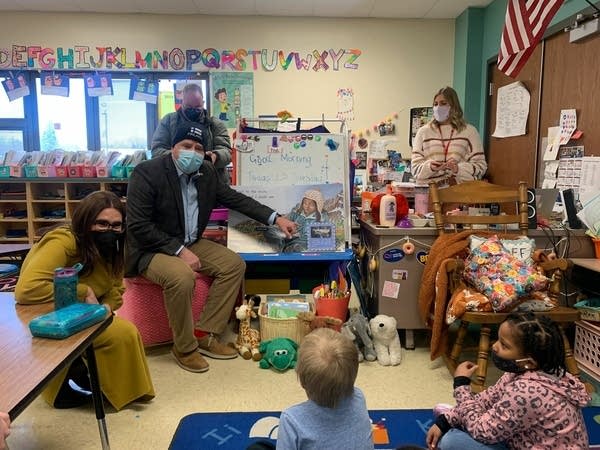Classrooms, child care, kids' meals top Walz spending plan

Go Deeper.
Create an account or log in to save stories.
Like this?
Thanks for liking this story! We have added it to a list of your favorite stories.
Gov. Tim Walz pitched an expansive spending plan Tuesday that would boost funding for schools, expand teacher training programs and increase access to student meals and mental health services.
In outlining the $5.1 billion proposal, the DFL governor also revived his push for a 12-week paid family and medical leave system and guaranteed time off for sickness or other household emergencies.
The key elements of his legislative session agenda are supported by a projected $7.75 billion surplus and more than $1 billion in unspent federal COVID-19 relief money.
It sets up an election-year session debate over the state’s priorities as Walz and most legislators prepare to face voters. Walz, a first-term DFLer, said he’s ready to reach for a deal.
Turn Up Your Support
MPR News helps you turn down the noise and build shared understanding. Turn up your support for this public resource and keep trusted journalism accessible to all.
“This is a time of optimism. This is a time to stop the drama,” Walz said at Hilltop Elementary School in Inver Grove Heights, Minn. “We certainly know this is about negotiations. It’s about making sure we get things right.”
Last week, Walz proposed billions of dollars toward pandemic front-line worker bonuses, tax rebates for most filers and replenishment of an unemployment fund that took on debt during the last couple of years. Without a patch to that fund, businesses will see higher taxes.
He’s set to outline a public safety proposal on Wednesday, the same day majority Senate Republicans list their session and surplus priorities.

The bulk of the Walz spending plan revolves around the youngest Minnesotans. He recommended a 2 percent increase to per-pupil aid for schools, the bedrock and most flexible allowance that districts receive. That’s on top of a bump of that size approved last summer.
The plan would also set aside $183 million to provide free school meals to all students, subsidizing the breakfast and lunch programs at public schools. Access to prekindergarten programs would expand and the state would strive to get rid of affordable child care waiting lists by absorbing more of the cost. Other child care programs would see better reimbursement rates.
Lt. Gov. Peggy Flanagan, who with Walz toured the elementary school and listened to the concerns of staff, said the plan addresses gaps that the COVID-19 pandemic exposed.
“Right now families across the state are struggling. And some have been struggling for a very long time,” she said “We have an opportunity but we also have an obligation to take action on their behalf.”
Republicans blasted it all as a spending spree.
Walz is sure to face an uphill climb for some initiatives, including his call for new paid family leave and sick leave benefits. That’s because those would require added employer taxes into the future to keep going.
“We’ve heard the calls from parents and working Minnesotans to have a flexible, free-market solution to help them care for their families and we will work on solutions to meet their needs,” Sen. Julia Coleman, R-Chanhassen, said in a statement. “A bureaucratic, government-run, one-size-fits-all program that taxes Main Street businesses and their employees is not the answer to meet the individual needs of parents and caregivers.”
Meanwhile, House DFLers unveiled the latest plank in their unfolding session framework. They also focused on education and child care. Their proposal calls for increased funding in K-12 schools, early childhood education, child care and a tuition freeze for college and universities.
The cost of the latest proposal is unclear, but it is at least $1 billion.
“Democrats fought for more investment in education and workforce training, and our compromise budget came up short,” said House Speaker Melissa Hortman, DFL-Brooklyn Park. “Now we have an opportunity to go back and add in those places where we know increased investment is warranted.”
Rep. Jim Davnie, DFL-Minneapolis, the chair of the House education finance committee, said lawmakers have a chance to make “once-in-a-generation investment” to fix school funding problems.
The 2022 session begins Monday and is set to conclude by mid-May.
MPR News reporter Tim Pugmire contributed to this story.


